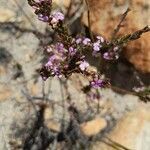Perennial herb, parasite, 0.04-0.60 m high; stem tufted, green-yellow, usually branching from base, puberulent. Leaves 5-10 x 2-3 mm, scale-like, appressed, puberulent. Inflorescence a terminal spike; flowers opposite or alternate. Bracts usually same length as calyx. Calyx (4-)6 x 2 mm. Corolla light blue or dark purple; tube bent below limb; upper lobes sharply recurved. Ovary with exserted stigma. Flowering time July-Mar.
Perennial, holoparasitic herb, up to 0.3 m high; dusky when dry, puberulous or nearly glabrous. Stems glabrous or slightly pubescent, ± succulent. Leaves all scale-like. Flowers: many in spikes; calyx 5-ribbed, each ending in a calyx tooth; corolla pink, reddish purple, mauve, purple or white; Jan.-Apr.
Parasitic herb, up to 300 mm tall, dusky when dry, puberulous or nearly glabrous. Leaves all scale-like. Calyx 5-ribbed. Flowers numerous, spicate, pink, reddish purple, mauve, purple or white.
Corolla 1.2–1.5 cm. long, light blue or dark purple; bend in tube just below limb. Upper lobes 2–2.5 mm. long, sharply recurved, lower 3–3.2 mm. long.
Single large primary haustorium c. 1–2 cm. in diam. usually present on each plant; adventitious roots abundant from subterranean scales.
Sparsely hairy, hemiparasitic perennial, black on drying. Leaves scale-like. Flowers pink to mauve, calyx 5-ribbed.
Stiff erect perennial herb with usually rather stout stems a few inches to 1 ft. or more high
Tufted, greenish-yellow, succulent herb, usually branching from base, 11–25(35) cm. tall.
Leaves and stems minutely puberulent with upward pointing hairs to almost glabrous.
Flowers opposite or alternate, usually 2, rarely 3 per node, not fragrant.
Bracts usually same length and width as calyx, acuminate.
Bracteoles minute, three quarters the length of calyx.
Leaves scale-like, appressed to stem, 5–10 x 2–3 mm.
Calyx 4–6 mm. long (including teeth), 2 mm. wide.
Pollen mass usually persistent on stigma.
Stems square but only obtusely angled.
Flowers pink or purple or creamy white
Capsules 1–2 x 3 mm.
Drying black.

